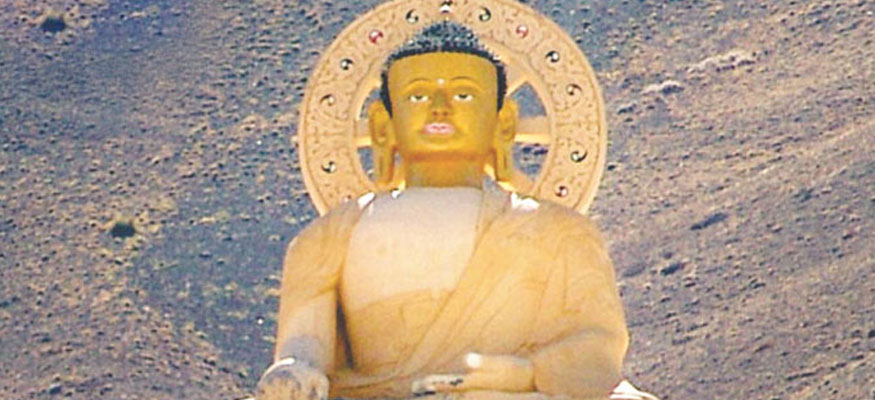
| Duration : | Optional | Places Covered : | On Demand |
Subhash Baoli
Netaji Subhash Chandra Bose spent a large portion of 1937 contemplating here. A nice secluded place.
Keylong
The little town of Keylong is the headquarters of the administrative district of Lahaul & Spiti. It has a marketplace, filling stations and medical facilities. Keylong lies above the river Bhaga and is 6 Km from its confluence with the waters of the Chandra at Tandi.Keylong was also the base of the Moravian missionaries - and the poplar trees still growing there, were planted by them.
Guru Ghantal Monastery
This lies high over the confluence of the rivers Chandra and Bhaga and is regarded as the oldest monastery in Lahaul. Two great figures of Trans Himalayan Buddhism were associated with it - Padmasambhava and Rinchensang-po. The monastery enshrines and image of the goddess Vajreshwari Devi (Do-jeLha-mo), a wooden image of the Buddha and a marble head of Avalokitesvara - legend has that this head was seen emerging out of the sandbank where the rivers Chandra and Bhaga meet and without waiting for the rest of the body to appear, someone lopped this off. The faithful also believe that in the Guru Ghantal monastery, and sealed in a dark airless room, is the visage of the demon Tsedak who once ravaged that area till he was captured.
Khardang
Visible from Keylong the monastery and village of Kardang lie across the Bhaga. With a backdrop of bare mountains, the monastery is believed to date back to the 12th century and is one of the most revered places of the Drug-pa (Red Hat) sect and has large library of the sacred Kangyur and Tangyur texts - and is also the repository of some exquisite thangka paintings, musical instruments and old weapons. For a long time the monastery was in a state of disrepair till it was revitalised by Lama Norbu in 1912. At Kardang, there are dozens of resident monks and nuns - and many more who are there for short periods. Several monks are believed to have undertaken marathon meditations - with the session lasting for the traditional period of three years, three months and three days. The village of Kardang was once the 'capital' of Lahaul.
Shashur
On the same slope as Keylong, this monastery is surrounded by a rare patch of woodland and was founded in the seventeenth century by Deva Gyatso-and the name 'Shashur` means 'in the blue pines'. The festival of Shashur Tseshe is held every June/July when monks dressed in masks and colourful costumes perform dances. The monastery is known for the images and paintings it houses.
Tayul
Tayul' means the "place that is chosen", and so it must be for local legend maintains that the main prayer wheel rotates on its own accord on certain occasions. It has a huge statue of Padmasabhava and its library houses the one hundred and one volumes of the sacred Kangyur text.
Gemur
This is a small monastery, but is held in great sanctity and is well known for its 'dance-drama' enacted every July.
Sissu
This is a small monastery, but is held in great sanctity and is well known for its 'dance-drama' enacted every July.
Jispa
Attractively sited near the confluence of two side streams of the river Bhagat this is a small village which also has religious significance.
Sarchu
After the Tanglang La, this is the last point in Himachal on the route to Leh.
Gondhla
On the right bank of the river Chandra, this is en route from Manali to Keylong. Gondhla has level stretches of cultivated land and its most distinctive feature is the eight-storeyed timber and stone tower that was the residence of the local 'thakur', chief. The monastery has historical importance and every July, this is the site of a large fair where masked dances commemorate the victory over Tibetan King, Langdarma, an enemy of Buddhism. Opposite Gondhla, a sheer cliff rises over 1500 m and forms a spectacular sight.
Tandi
This has the confluence of rivers Chandra and Bhaga. A folktale about the place speaks of Chandra, the daughter of the moon and Bhaga, son of the sun. Both fell in love and decided to have a marriage that would last forever and to sanctify this, they decided to circle of all of Lahaul and then meet. After great difficulty, they managed to reach Tandi where they were united.
Shansha
The deity Gyephang is regarded to have been born here and a shrine is dedicated to him.
Jalma
Located in the Pattan valley by the waters of the Chandrabhaga, this is considered to be the legendary abode of many of Lahaul's deities.
Trilokinath
Its shrine is revered by both Hindus and Buddhists and both pay homage to a single image. The Hindus regard 'Trilokinath' as Bhagwan Shiva, while the Buddhists regard the image to be that of Avalokiteshwara, the personification of compassion and infinite light. It is the site of an important fair called 'Pori' held in August.
Udaipur
This has an ancient temple dedicated to Devi Durga and has come fine carvings.
Baralacha La
This means 'the pass with the crossroads on the summit'. And here meet the paths from Zanskar, Ladakh, Spiti and Lahaul. It is 8 Km long and is on the Manali-Leh route. This is also the watershed for the Chandra, Bhaga and Yunam rivers.
Kunzam La
This pass connects Lahaul with Spiti over the Kunzam range and the majestic Shigri peak is visible from its crest.
Chandra Tal
6 Km from the Kunzam Pass, this lake is surrounded by snows and acres of scree and its deep blue-waters have a circumference of 2.5 Km. The lake is planned for incorporation in the Ransar Convention of international wetlands.








